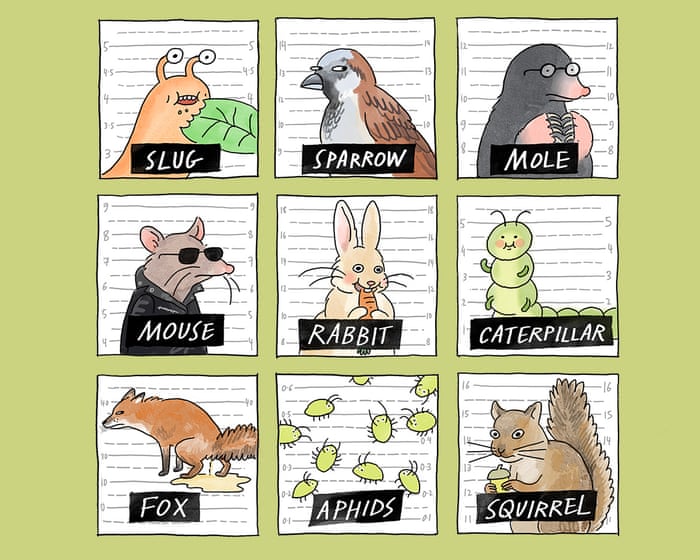Every gardener understands that our outdoor spaces are home to countless creatures. This is generally a good and essential part of nature. Most wildlife is helpful and deserves a friendly welcome. Given the current biodiversity crisis, we need to rethink what we consider a “pest.” That said, some organisms can threaten our gardening efforts.
When I learned organic gardening principles, I was taught a thoughtful approach to dealing with pests: start with the least disruptive solutions before considering harsher measures.
The first step in reducing pest damage is attracting wildlife to your garden. A balanced ecosystem allows natural predators to control plant-harming creatures. Additionally, growing strong plants in healthy soil creates a more resilient garden.
If a particular pest returns each season or targets a specific plant, physical barriers can protect your plants without disturbing the ecosystem. For example, insect-proof mesh can stop carrot root flies.
Despite our best efforts, damage sometimes goes unnoticed until it’s too late. However, I recommend avoiding chemical solutions that harm the environment or wipe out entire populations, as this disrupts food chains. Before trying quick fixes from social media, consider these more effective methods.
### Do eggshells and coffee grounds stop slugs and snails?
Slug management is a common question, though the Royal Horticultural Society no longer labels them as pests—only nine of the UK’s 44 slug species are known to damage plants.
In my experience, coffee grounds and eggshells don’t work well. Beer traps do lure slugs to a yeasty demise but require regular maintenance, which isn’t pleasant. Their effectiveness depends on how many you use and your slug population.
A better approach is removing hiding spots (like wood, bricks, or edging) near plants and encouraging natural predators—frogs, newts, and toads—by adding a pond and wild areas. Nematodes work too, but only in confined spaces, as they need boundaries to be effective.
Some gardeners swear by wool barriers, but I doubt they last through heavy rain or watering.
### Does peeing in the garden scare off foxes?
Foxes once chewed through my irrigation pipes weekly—maddening! While human urine might disrupt their territory (especially in rural areas), city foxes are too used to people. You’d likely need to pee outside daily for it to work.
A better solution is sealing fence gaps, securing bins, and making food sources less accessible. If foxes leave droppings, try chilli or garlic as deterrents—they hate the smell. Covering bare soil with holly clippings also makes for an uncomfortable toilet spot.
### Will old CDs protect my strawberries from birds?
(Note: The original text was cut off, but reflective objects like CDs can sometimes startle birds temporarily. However, birds often get used to them, so netting is usually more reliable.)Birdwatching is one of the great joys of spending time in green spaces. However, some birds are just as keen on our homegrown kale and strawberries as we are.
Hanging CDs or recycled foil around the garden can reflect light and deter birds, but my preferred solution is bird-proof netting—securely fastened at the edges or draped over a cage to prevent birds from slipping underneath and getting trapped.
A traditional scarecrow might work briefly, but birds quickly get used to it. If you don’t mind your garden looking like a used car lot, an inflatable dancing tube man could be more effective.
### Is pesticide the only way to protect brassicas?
Several butterflies and moths lay their eggs on brassica leaves. Once the caterpillars hatch, they can strip a healthy purple sprouting broccoli down to its skeleton in days. Cabbage white butterflies are a guaranteed visitor to my vegetable patch every year—so much so that I had no kale at all in 2023.
Since butterflies and moths are a vital food source for bats and other wildlife, it’s best to deter them from laying eggs on your crops rather than eliminating them. The most effective method I’ve found is fine insect-proof mesh, which also keeps pigeons from shredding leaves. Planting nasturtiums nearby can help too—though they’re not brassicas, cabbage whites will happily lay eggs on them instead.
### Can I just wash aphids off my plants?
Aphids suck sap from new growth, causing distorted and stunted plants while spreading disease. They’re common and feed on a wide variety of plants, but they’re also a key food source for ladybirds, lacewings, hoverflies, and birds. I don’t panic when I see them because their predators usually keep their numbers in check.
For low-intervention control, try pinching off affected plant tips, growing sacrificial plants like nasturtiums, or gently rinsing aphids away with water. Avoid “natural” remedies like neem oil, which harm more than just the target pests.
### Is calling the ‘mole man’ the only way to get rid of a mole?
Moles, like ants, aren’t after your plants—but their underground tunneling can wreak havoc. They feast on earthworms and other soil life, so if you’ve enriched your soil with compost, it’s no surprise a mole might move in.
Since moles are territorial, you likely only have one in your garden. The most humane way to encourage it to leave is by disturbing it—moles are highly sensitive to vibrations and noise. You can buy ground-buzzing devices or simply stomp around your garden daily.
A neighbor once offered me the number of a “mole man,” but I’d rather have an empty vegetable patch than a mole’s death on my conscience.
### Does boiling water get rid of ants?
Ants themselves aren’t usually a problem (though red ant bites can be painful), but they can worsen aphid infestations. Ants “farm” aphids by moving them onto plants, then feeding on the honeydew they excrete.
Ants prefer dry soil, so regular mulching to keep the soil moist can discourage them from nesting near your plants. If they’re already there, maintaining damp (but not waterlogged) soil may encourage them to relocate.Here’s a more natural and fluent version of your text while keeping the original meaning intact:
—
How can I protect my beans from hungry mice?
Whether you’re gardening in the countryside or the city, mice are never far away. They love nibbling on all kinds of plants—from sprouting peas to freshly planted bulbs—and once they start feasting on your garden, it can be enough to make you want to quit.
Dealing with these little pests can be tricky. While a cat would certainly help, not everyone can have one (like me—I’m severely allergic). Instead, try using row covers or fine mesh secured tightly over your plants. I’ve also found that scattering prickly holly clippings around your plants works well—just like it does for keeping foxes away.
—
This version keeps the advice clear and conversational while removing any awkward phrasing. Let me know if you’d like any further refinements!




